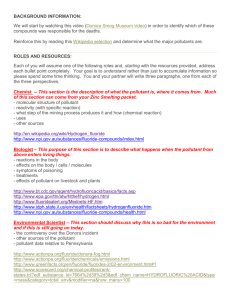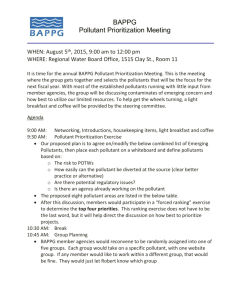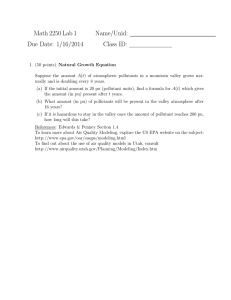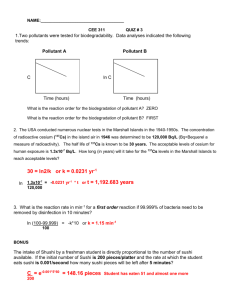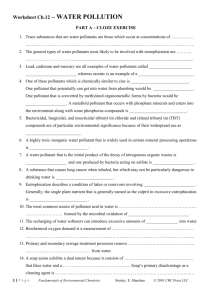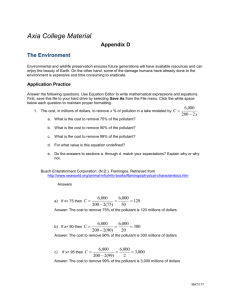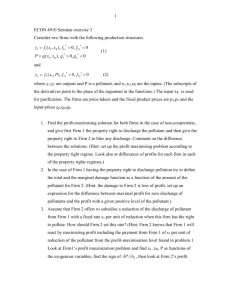Document 13359641
advertisement
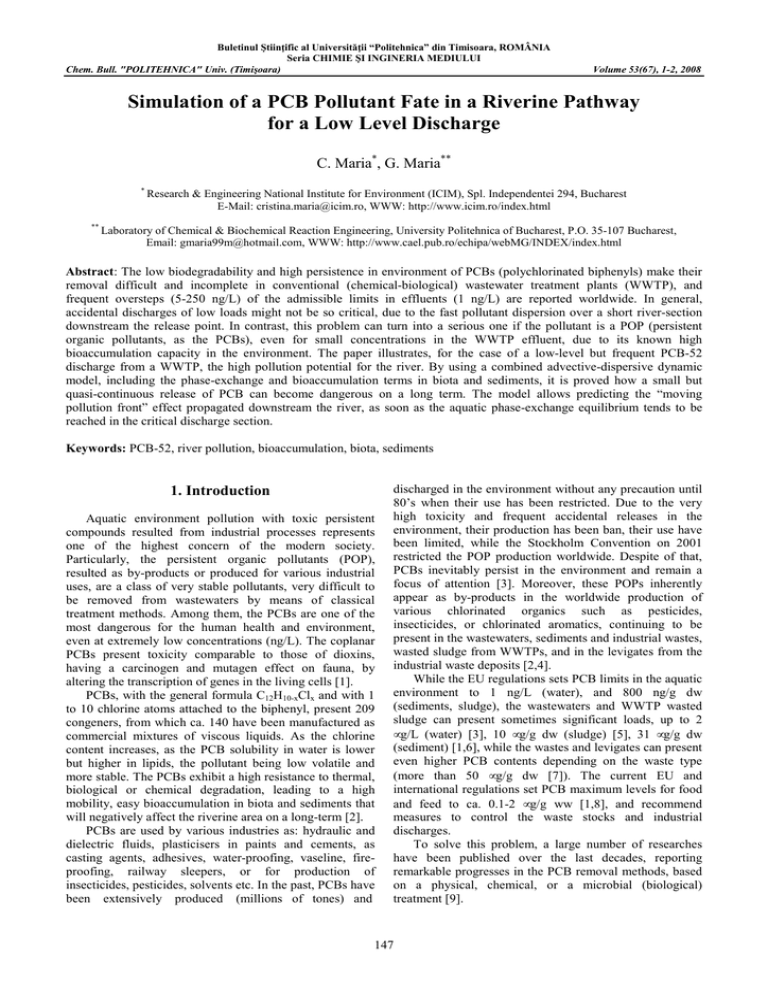
Buletinul Ştiinţific al Universităţii “Politehnica” din Timisoara, ROMÂNIA Seria CHIMIE ŞI INGINERIA MEDIULUI Chem. Bull. "POLITEHNICA" Univ. (Timişoara) Volume 53(67), 1-2, 2008 Simulation of a PCB Pollutant Fate in a Riverine Pathway for a Low Level Discharge C. Maria*, G. Maria** * ** Research & Engineering National Institute for Environment (ICIM), Spl. Independentei 294, Bucharest E-Mail: cristina.maria@icim.ro, WWW: http://www.icim.ro/index.html Laboratory of Chemical & Biochemical Reaction Engineering, University Politehnica of Bucharest, P.O. 35-107 Bucharest, Email: gmaria99m@hotmail.com, WWW: http://www.cael.pub.ro/echipa/webMG/INDEX/index.html Abstract: The low biodegradability and high persistence in environment of PCBs (polychlorinated biphenyls) make their removal difficult and incomplete in conventional (chemical-biological) wastewater treatment plants (WWTP), and frequent oversteps (5-250 ng/L) of the admissible limits in effluents (1 ng/L) are reported worldwide. In general, accidental discharges of low loads might not be so critical, due to the fast pollutant dispersion over a short river-section downstream the release point. In contrast, this problem can turn into a serious one if the pollutant is a POP (persistent organic pollutants, as the PCBs), even for small concentrations in the WWTP effluent, due to its known high bioaccumulation capacity in the environment. The paper illustrates, for the case of a low-level but frequent PCB-52 discharge from a WWTP, the high pollution potential for the river. By using a combined advective-dispersive dynamic model, including the phase-exchange and bioaccumulation terms in biota and sediments, it is proved how a small but quasi-continuous release of PCB can become dangerous on a long term. The model allows predicting the “moving pollution front” effect propagated downstream the river, as soon as the aquatic phase-exchange equilibrium tends to be reached in the critical discharge section. Keywords: PCB-52, river pollution, bioaccumulation, biota, sediments 1. Introduction Aquatic environment pollution with toxic persistent compounds resulted from industrial processes represents one of the highest concern of the modern society. Particularly, the persistent organic pollutants (POP), resulted as by-products or produced for various industrial uses, are a class of very stable pollutants, very difficult to be removed from wastewaters by means of classical treatment methods. Among them, the PCBs are one of the most dangerous for the human health and environment, even at extremely low concentrations (ng/L). The coplanar PCBs present toxicity comparable to those of dioxins, having a carcinogen and mutagen effect on fauna, by altering the transcription of genes in the living cells [1]. PCBs, with the general formula C12H10-xClx and with 1 to 10 chlorine atoms attached to the biphenyl, present 209 congeners, from which ca. 140 have been manufactured as commercial mixtures of viscous liquids. As the chlorine content increases, as the PCB solubility in water is lower but higher in lipids, the pollutant being low volatile and more stable. The PCBs exhibit a high resistance to thermal, biological or chemical degradation, leading to a high mobility, easy bioaccumulation in biota and sediments that will negatively affect the riverine area on a long-term [2]. PCBs are used by various industries as: hydraulic and dielectric fluids, plasticisers in paints and cements, as casting agents, adhesives, water-proofing, vaseline, fireproofing, railway sleepers, or for production of insecticides, pesticides, solvents etc. In the past, PCBs have been extensively produced (millions of tones) and discharged in the environment without any precaution until 80’s when their use has been restricted. Due to the very high toxicity and frequent accidental releases in the environment, their production has been ban, their use have been limited, while the Stockholm Convention on 2001 restricted the POP production worldwide. Despite of that, PCBs inevitably persist in the environment and remain a focus of attention [3]. Moreover, these POPs inherently appear as by-products in the worldwide production of various chlorinated organics such as pesticides, insecticides, or chlorinated aromatics, continuing to be present in the wastewaters, sediments and industrial wastes, wasted sludge from WWTPs, and in the levigates from the industrial waste deposits [2,4]. While the EU regulations sets PCB limits in the aquatic environment to 1 ng/L (water), and 800 ng/g dw (sediments, sludge), the wastewaters and WWTP wasted sludge can present sometimes significant loads, up to 2 µg/L (water) [3], 10 µg/g dw (sludge) [5], 31 µg/g dw (sediment) [1,6], while the wastes and levigates can present even higher PCB contents depending on the waste type (more than 50 µg/g dw [7]). The current EU and international regulations set PCB maximum levels for food and feed to ca. 0.1-2 µg/g ww [1,8], and recommend measures to control the waste stocks and industrial discharges. To solve this problem, a large number of researches have been published over the last decades, reporting remarkable progresses in the PCB removal methods, based on a physical, chemical, or a microbial (biological) treatment [9]. 147 Chem. Bull. "POLITEHNICA" Univ. (Timişoara) Volume 53(67), 1-2, 2008 A classical WWTP consists in a series of sections: primary (mechanical and chemical), secondary (biological) and, in modern configurations, a tertiary (advanced) pollutant treatment. The biological treatment is the most complex but also sensitive to perturbations in influent loads or operating conditions, being conducted in coupled aeration basin – sludge settler units with activated sludge. Sudden increases in substrate concentration, presence of inhibitory substances or POPs, deterioration of the biomass, or the low flexibility of the aerator-settler unit, all these can lead to a difficult process control [10,11]. In spite of various improvements [12], the WWTP safe operation can become a critical issue, being related to the pollutant type and maximum input loads that can safely be processed. On the other hand, introduction of a supplementary wastewater treatment step for large discharged flow-rates is very costly. The presence of PCBs in wastewaters, of whose neutralisation is difficult, makes their removal in WWTPs to be problematic and often incomplete. Application of the conventional chemical-biological treatment can remove max. 45% of PCBs, while addition of other reagents (such as Fenton) in the chemical phase can lead to a max. 51% removal yield [13,14]. Even if an adapted sludge is used, the effluents from WWTP can still contain 1.4-4.3 ng/L PCBs (in Montreal area [15]), or 250 ng/L (Thessaloniki area [3]). As a consequence, difficulties to obtain a satisfactory removal of PCBs from urban, agriculture sewerage or industrial discharges when the WWTP possibilities are limited, can periodically lead to overstep the maximal admissible limits in the surface water discharge section. If the released amounts of PCBs are quite small, the concentrations in the WWTP effluent (of ca. 1-5 ng/L) can be close to the admissible limits, and the pollutant may quickly be dispersed over a small-size section of the river, downstream the WWTP release point. The pollution problem seems to be in this case very limited. However, if such a situation persists, it is questionable what effect can have such an incomplete treatment of PCBs in WWTPs on a long term and on the whole riverine area. The scope of this paper is to illustrate, in the case of a low-level but frequent PCB-52 discharge from a WWTP, the high pollution potential for the river. By using a combined advective-dispersive dynamic model, including the phase-exchange and bioaccumulation terms in biota and sediments, it is proved how a small but quasi-continuous release of PCB can become dangerous for the whole riverine pathway on a long term. The model allows predicting the “moving pollution front” effect propagated downstream the river over long time intervals, as soon as the aquatic phase-exchange equilibrium tends to be reached in the critical discharge section. Such a study can be of help for a WWTP risk assessment, when the low quantities of released pollutant appear not to raise critical situations due to the fast pollutant dispersion over a relatively small section of the river pathway. The low level but continuous pollution can however turn into a serious one if the pollutant belongs to the POP class, due to their very high bioaccumulation capacity in biota and sediments, very low biodegradability and long-term persistence in the aquatic environment. 2. Dispersion and bioaccumulation model in the riverine pathway To model the pollutant fate in a surface water two main approached have been developed: i) characterization of the pollutant partition among various phases in contact under equilibrium conditions, and ii) simulation of the pollutant dispersion dynamics in water and bioaccumulation in sediments, biota, or volatilisation in air. The equilibrium models are based on defined partition coefficients K ij of the pollutant between every two phases in contact, that is [16]: K ij = k ij / k ji = c*j / c*i [where: i , j = the phases in contact, i.e. water (‘w’), aquatic fauna and plants (biota ‘b’), sediments and sludge (‘s’), suspended solids, air/aerosols; k ij = uptake rate constant of the pollutant from phase i to phase j; k ji = clearance rate constant of the pollutant from phase j; ci = concentration of the pollutant in the phase i; ‘*’ denotes the equilibrium value]. The coefficients K ij are determined experimentally or, when no such data are available, they are correlated with the structural characteristics or properties of the pollutant, such as the K ow (octanol-water partition coefficient of the pollutant) or S w (aqueous solubility of the chemical). Compartmented multi-phase and multisegment models (based on the fugacity approach) allow to predict the pollutant fate in lakes or rivers, based on a series of well-mixed inter-connected water sections (boxes) at quasi-equilibrium [16]. Dynamic models are based on the classical formulation of the pollutant dispersion in the riverine pathway as differential mass balance equations written for an infinitesimal element of the river. By considering a turbulent field and the flow main characteristics, the dispersion model can be of various complexities: onedimensional 1D (accounting for only longitudinal direction x), bi-dimensional 2D (longitudinal and lateral directions x, y), tri-dimensional 3D (longitudinal, lateral, and vertical directions x, y, z) [17-19]. These models are usually solved numerically by imposing initial and limit conditions specific to the pollution source (continuous or intermittent) and river topology. Even if more precise than the fugacity compartmental approach, the differential transport models meet difficulties with including changes in the flow volume, velocity, or river width or depth, requiring separate solutions on different river sections and a significant computational effort to simulate dynamic conditions. However, with the increase of computing facilities, differential models can offer accurate simulations of pollutant dispersion with even including several phenomena, such as: absorption / desorption of gases / pollutant from/to atmosphere through the river surface; chemical and biological pollutant degradation; interaction with multiple receptors from the aquatic environment; 148 Chem. Bull. "POLITEHNICA" Univ. (Timişoara) Volume 53(67), 1-2, 2008 pollutant adsorption in suspended solids, sediments, or living organisms, etc. The adopted 2D advective-dispersive dynamic model can predict the pollutant concentration field c( x , y , t ) in the river downstream a small-size continuous release point, by solving the following mass balance [19-21]: ∂c ∂c ∂ 2c + wx = Dy + ∑ i ri ; ∂t ∂x ∂y 2 clearance rates ( rc ). ∂c = 0 , for y = 0 , and y = B ; ∂y c = 0 , for y = B ; c = co , for x = 0 , y = 0 , 3. Case study: PCB-52 fate for a low level continuous discharge (1) where: y= lateral distance from middle-river; B= river halfwidth; wx = water-mean velocity in the flow direction; D y = apparent lateral dispersion coefficient; t= time. The accounted reaction or phase transport rates ri lead to disappearance or appearance of the pollutant in the river (e.g. pollutant evaporation / runoff, biodegradation, uptake or clearance by/from biota, sediments, suspended solids, river bed). Such a model is based on several simplificatory assumptions: i) a small size discharge source, with a continuous release flow-rate ( Qef ) including the pollutant flow-rate ( Qc ), and located in the middle of the river (y=0); the release water temperature and dissolved oxygen are approximately the same with those of the river; ii) contaminant release time in the riverine pathway is much longer than the travel time ( t = x / w x ) in the control section, from the source to a receptor located at a relevant distance; iii) an uniform longitudinal flow with a constant flow-rate ( Q ) and velocity ( wx ) over the analysed time interval; iv) a prismatic river-geometry with an approximately constant rectangular cross-section, of width B and depth h ; v) quasi-constant water quality parameters, averaged over the analysed time interval; vi) negligible adsorption/desorption of the pollutant from the river to suspended solids (others than biota or sediments); if these are proved to be important, a supplementary pollutant exchange rate must be added to the mass balance term ∑ i ri ; vii) an advection which dominates dispersion in the longitudinal direction ( D x = 0 ); viii) a fully mixed contaminant plume over the river depth (i.e. vertically homogeneous water concentration field); ix) a constant lateral dispersion coefficient ( D y ) that includes the lateral turbulent mixing and diffusion; a value of D y = 0.06 hw x is adopted following the recommendations of Fischer [22]. By assuming that pollutant biodegradation occurs only in the water (index ‘w’), the inter-phase exchange dynamics of the contaminant can usually be satisfactorily represented by a pseudo first-order kinetics, of the form: dc w = rd + ru + rc = dt − k d c w − ∑ k we Fe c w + ∑ k ew Fe c e where: index ‘e’ denotes the phases in contact with the water; Fe = ratio of two phase quantities being in contact (referred to the water volume). At limit, for t → ∞ , the thermodynamic equilibrium is reached, i.e. K we = k we / k ew for all the phases in contact. The last two terms in (2) account for the bioaccumulation kinetics in the phases ‘e’, i.e. the pollutant uptake ( ru ) and (2) The approached case study consists in a low-level (ca. 4 ng/L) discharge of a PCB-52 pollutant from a WWTP with incomplete removal possibilities. The input data, including the river and discharge characteristics together with the constant flow rates are presented in Table 1 (annual average values). In order to simulate the pollutant fate in the riverbed, a control section of x max = 1000m is considered downstream the source point. The released PCB-52 (i.e. 2,2’,5,5’ tetrachlorobiphenyl) is one of the most persistent POPs (see the characteristics in Table 1). PCB-52 presents a low solubility and vapour pressure, a low biodegradability (small k d ), but a high bioaccumulation potential in biota and sediments (large k wb and k ws ) compared to their clearance rates (small k bw and k sw ). A value of Log ( BCF ) =4.69 >> 2÷3 [23] and Log ( K ow ) =5.92 > 5.0-5.5 [24,25] clearly indicate a pollutant with a high bioaccumulation and biomagnification potential. To simulate the pollutant fate over ca. one year, a combined numerical - analytical procedure has been developed, by using a time discretization uniform step of ∆t = 1 day. During one integration step, the pollutant dispersion can be considered at quasi-stationary state ( dc w / dt ≈ 0 ), the contaminant release time being longer than the travel time in the river control section. Thus, the analytical solution of model (1) can be obtained of the form [21,26]: Q c( x , y , t ) = c fond + c disp ( x , y ) × Q + Qef kc exp(− k M t ) + (1 − exp(− k M t )) ; kM k M = k d + k wb Fb + k ws Fs ; k c = k bw Fb cb + k sw Fs c s , (3) where: c disp = dispersed pollutant concentration at various locations downstream the river; k M = the apparent McKinney rate constant; k c = the apparent clearance rate of pollutant from the phases in contact with the water. The k c constant has been constructed by considering quasiconstant concentrations of PCB-52 in biota and sediments over one time-step, being taken at the previous values c e ( x , y , t − ∆t ) for every river location. 149 Chem. Bull. "POLITEHNICA" Univ. (Timişoara) Volume 53(67), 1-2, 2008 TABLE 1. Input data for the simulation model of the pollutant fate in the riverine pathway (a) River topological/water data Symbol Significance x longitudinal flow-direction (x=0 at pollutant release location) y lateral distance from the river middle (y=0) to a lateral receptor z vertical distance from the water surface (z=0) half of the river width B average river depth in the h control section river average flow-rate Q wx Dy river mean velocity in the flow direction lateral dispersion coefficient Value 0 ≤ x ≤ xmax = 1000 (m) Notes: (a) Fb = ρ b ybw ; avg. biota density ρ b = 1000 kg/m3; vol. fraction in water y bw = 10-4 (plants, fauna) [16,27]; (b) Fs = δ s ρ s / h ; δ s =0.1m is the active sediment depth [27]; ρ s = 1500 kg/m3 . 0 ≤ y ≤ B (m) 0 ≤ z ≤ h (m) 50/2 (m) h = ( Q + Qef ) /( 2 Bw ) 30 (m3/s) 0.2 (m/s) D y = 0.06 hu = 3.8×10 -2 2 (m /s) (b) Pollution source data Symbol Significance discharged pollutant / Qc contaminant flow-rate discharged water flow-rate (at Qef x=0) (average) pollutant concentration in the cef discharged water (average, before mixing) pollutant concentration before c fond the release point pollutant concentration at the co release point (x=0) after mixing max. admissible PCB cmax concentration in the river 2D dynamic concentration c( x , y ,t ) field of the pollutant, downstream the release point (avg. on the depth) (c) PCB-52 pollutant characteristics Symbol Significance overall biodegradation rate kd constant (average) water-biota overall uptake k wb rate constant biota-water clearance rate k bw constant pv water-biota bioconcentration factor water-sediment overall uptake rate constant sediment -water clearance rate constant water-sediment bioconcentration factor biota content of river relatively to the water active sediment content of river relatively to the water octanol to water partition coefficient organic carbon to water partition coefficient dissolved organic carbon to water partition coefficient solubility in water vapour pressure He Henry’s constant Lg ( BCF ) k ws k sw Lg ( K ws ) Fb Fs Lg ( K ow ) Lg ( K oc ) Lg ( K doc ) Sw Value 1.3×10-7 (kg/s) 2.0 (m3/s) Figure 1. PCB-52 pollutant concentration field in the river, biota and sediment, downstream the discharge point after 250 days of continuous release (avg. 1.3×10-7 kg PCB/s) cef = Qc / Qef 0.1 ng/L (average) ( Qc fond + Qc ) /( Q + Qef ) = 4.06 ng/L 1 ng PCB/L 250 days 1000 days 250 days 1000 days 1 day dispersion model solution (kg/m3) Value (Reference) 2.74×10-4 (1/day) [27] 740 (L/day kg ww) [28] 0.015 (1/day), [28] BCF = k wb / k bw 4.69 (L/kg ww) [28] 3256 (L/day kg dw), [29] 0.1032 (1/day) [29] 4.50 (L/kg dw) [29] K ws = K wb / BSAF 5×10-5 (kg ww/L water) (a) 4.7×10-2 (kg dw/L water) (b) 5.92 [27] 1000 days 1 day 250 days Figure 2. Pollutant (PCB-52) concentration dynamics along the river longitudinal axis (y=0) in water, biota and sediment downstream the release point (for an average discharged pollutant flow-rate of 1.3×10-7 kg PCB/s) To derive an analytical solution of (2), the PCB-52 concentrations in water for each spatial location of the river downstream the release point are kept constant over one time-step, at values corresponding to the current time step ~ c w ( x , y ) = c w ( x , y , t ) . The solution becomes: k ~ c ( x, y ) (1 − exp(− k ew t )) + c e ( x , y , t ) = we w k ew 4.65 [27] c e ,o ( x , y ) × exp(−k ew t ) 4.79 [27] 66.7 µg/L [27] 2.08×10-2 (Pa) [27] 91 (Pa m3/mol) [27] 150 (4) Buletinul Ştiinţific al Universităţii “Politehnica” din Timisoara, ROMÂNIA Seria CHIMIE ŞI INGINERIA MEDIULUI Chem. Bull. "POLITEHNICA" Univ. (Timişoara) The solving procedure starts from the initial conditions of the river phases and WWTP discharge. Then, by successively evaluating the phase concentration fields (3) and (4) with a chosen time-increment, one finally obtains the dynamics of the PCB distribution in water c w ( x , y ,t ) , biota cb ( x , y ,t ) , and sediment c s ( x , y ,t ) . Simulations are performed over ca. 250 days of continuous pollutant release, because experimental investigations for PCB bioaccumulation in fish reported transient times between 15 and 256 days to reach the equilibrium after exposure to different pollutant concentrations [24]. The obtained results are presented in Figure 1, while the axial PCB-52 concentrations in the riverbed (for y = 0 ), downstream the release point ( x > 0 ), are displayed in Figure 2 for all the phases in contact. It is to observe that, over the first few days of release, the critical pollution front is located very close the to source, practically over less than 100m downstream the river (where the PCB concentration in the river is below the threshold of 1 ng/L; this Figure is not presented here). However, even if the discharge load is quite modest (of ca. 4 ng/L at source), the situation tends to change dramatically on a long term due to the PCB-52 low degradability and high bioaccumulations capacity. Thus, after 250 days of continuous release, the phase-equilibrium is practically reached over ca. 400m downstream; the critical thresholds are overstepped in water and biota (see Figure 2), and the pollution front continue to move down the river. By applying the simulation model, it is possible to predict the negative effects of a PCB low-level release over much longer time intervals, or for various discharge loads at source. 4. Conclusions Based on a combined dispersion-bioaccumulation dynamic model one can quickly simulate the pollutant transport and fate in a riverine pathway, downstream a contamination source. The model can reproduce stationary but also dynamic contamination conditions by means of a suitable chosen integration time-step and inter-phase exchange kinetic terms. Variations in flow-rates and pollutant loads can also be accounted for by keeping their quasi-stationarity over one integration step. Application of such a model in the case of a low-level but quasi-continuous discharge of a PCB-52 pollutant in the effluent of a conventional WWTP lead to predict the effects under various release scenarios. It is proved that, even for a low pollution level, the pollutant dispersion over a small section of the river-bed is not of low risk and can become a real danger over long-term. Such a result is explained by the PCB very low biodegradability and high bioaccumulation capacity in biota and sediments that make their presence in the aquatic environment to be of very long term. Simulations also prove that a longer release interval (more than 15 days) leads to reaching of the phaseequilibrium in the discharge section and then to a continuous moving-down of the pollution front. As a result, Volume 53(67), 1-2, 2008 the entirely riverbed can be slowly contaminated by means of such a pollution propagation effect. The model can be coupled with a statistical analysis associated to the accidental release of a pollutant, in order to derive the risk contours downstream the river in various release scenarios that concern discharges from a WWTP with incomplete treatment of certain pollutants [21]. REFERENCES 1. Nagpal, N.K., Water quality criteria for PCBs, Technical Appendix, Ministry of Environment, Lands and Parks, British Columbia (Canada), 1992. 2. Hester, R.E. and Harrison, R.M. (Eds.), Chlorinated organic micropollutants, The Royal Society of Chemistry, Thomas Graham House, Cambridge, 1996. 3. Katsoyiannis, A. and Samara, C., Persistent organic pollutants (POPs) in the sewage treatment plant of Thessaloniki, northern Greece: occurrence and removal, Water Research, 2004, 38, pp. 2685–2698. 4. Patureau, D. and Trably, E., Impact of anaerobic and aerobic processes on PolyChloroBiphenyl removal in contaminated sewage sludge, Biodegradation 2006, 17, pp. 9–17. 5. Benabdallah El-Hadj, T., Dosta, J., Torres, R. and Mata-Alvarez, J., PCB and AOX removal in mesophilic and thermophilic sewage sludge digestion, Biochemical Engineering Journal 2007, 36, pp. 281–287. 6. Bremle, G., Okla, L. and Larsson, P., Uptake of PCBs in fish in a contaminated river system: Bioconcentration factors measured in the field, Environ. Sci. Technol. 1995, 29, 2010-2015. 7. ECWWW, Environmental Canada’s World Wide Web, The Green Lane, Waste management, 2006. 8. CD-EC, Commission Directive 2006/13/EC, Official Jl. of the European Union, L32/44-L32/53, 4.2.2006. 9. Wikipedia Encyclopedia, Wikimedia Foundation Inc. (USA), 2007. http://en.wikipedia.org/wiki/ 10. Maria, G., Maria, C., Salcedo, R. and Feyo de Azevedo, S., Databank transfer-of-information, shortcut and exact estimators used in the wastewater biological treatment process identification, Computers & Chemical Engineering, 2000, 24, pp. 1713-1718. 11. Maria, G., Maria, C., Salcedo, R. and Feyo de Azevedo, S., Optimal monitoring and risk limits for a wastewater biological treatment serial plant, Proc. European Control Conference, Porto (Portugal), Sept. 4-7, 2001, pp. 3845-3851. 12. Beccari, M., Biological treatment of wastewaters: Stateof-the-art and research needs, Chem. Biochem. Eng. Quaterly, 1998, 12, pp. 175-181. 13. Aronstein, B.N., Paterek, J.R., Kelley, R.L. and Rice, L.E., The effect of chemical pretreatment on the aerobic microbial degradation of PCB congeners in aqueous systems, Jl. Industrial Microbiology 15, 1995a, pp. 55-59. 14. Aronstein, B.N. and Paterek, J.R., Effect of nonionic surfactants on the degradation of glass-sorbed PCB congeners by integrated chemical biological treatment, Environmental Toxicology & Chemistry 14, 1995b, pp. 749-754. 15. Bergqvist, P.A., Augulyte, L. and Jurjoniene, V., PAH and PCB removal efficiencies in Umea (Sweden) and Siauliai (Lithuania) municipal wastewater treatment plants, Water, Air, and Soil Pollution 2006, 175, pp. 291–303. 16. Mackay, D., Multimedia environmental models - The fugacity approach, Lewis Publ., Boca Raton, 2001. 17. NRG Report on hydrological (pollutant dispersion) models, Nuclear Research & Consultancy Group (NRG), Petten (Holland), 2001. 18. Ramaswami, A., Milford, J.B. and Small, M.J., Integrated environmental modelling. Pollutant transport, fate, and risk in the environment, John Wiley & Sons, Inc., New Jersey, 2005. 19. Maria, G., Quantitative risk evaluation of chemical processes and modelling of accident consequences, Ed. Printech, Bucharest, 2007 (640 pag., in Romanian). 20. Whelan, G. and McDonald, J.P., The multimedia environmental pollutant assessment system (MEPAS): Riverine pathway formulations, PNNL-11176/UC-630 Res. Report, Pacific Northwest National Laboratory, Richland, Washington, 1996. 151 Chem. Bull. "POLITEHNICA" Univ. (Timişoara) Volume 53(67), 1-2, 2008 21. Maria, G. and Maria, C., Evaluation of risk zones over a river pathway, downstream a release point, under seasonal pollutant biodegradability, Chemical & Biochemical Engineering Quarterly 2006, 20, pp. 333-342. 22. Fischer, H.B., Turbulent mixing and dispersion in waterways, Conference on Dispersion and Transport of Pollutants in Waterways, California State Univ., Riverside, Sept. 24, 1974. 23. Pedersen, F., Tyle, H., Niemela, J.R., Guttmann, B., Lander, L. and Wedebrand, A., Environmental hazard classification - Data collection and interpretation guide for substances to be evaluated for classification as dangerous for the environment, Tema Nord 1994:589, Nordic Council of Ministers, Copenhagen, 1994. 24. Carafa, R., Marinov, D., Dueri, S., Wollgast, J., Viaroli, P. and Zaldivar, J.M., Development of a bioaccumulation model for herbicides in Ulva and clams, European Commission, Directorate-General Joint Research Centre, Institute for Environment and Sustainability, EUR 22517EN Report, 2006. 25. Fisk, A.T., Norstrom, R.J., Cymbalisty, C.D. and Muir, D.C.G., Dietary accumulation and depuration of hydrophobic organochlorines: Bioaccumulation parameters and their relationship with the octanol / water partition coefficient, Environmental Toxicology and Chemistry 1998, 17, 951–961. 26. Maria, G. and Maria, C., Evaluation of limit-state-functions by means of a diffusion model in the risk assessment of a biodegradable pollutant discharge in a river pathway, Chem. Bull. POLITEHNICA Univ.(Timisoara), 2005, 50, 112-115. 27. NEHC - Navy Environmental Health Center, Ex-ORISKANY Artificial Reef Project, Prospective risk assessment model (PRAM), URS Corporation, SPAWAR Systems Center, San Diego, 2006. 28. Bruggeman, W.A., Martron, L.B.J.M., Kooiman, D. and Hutzinger, O., Chemosphere 1981, 10, pp. 811 - 852. 29. You, J., Landrum, P.F., Trimble, T.A. and Lydy, M.J., Availability of polychlorinated biphenyls in field - contaminated sediment, Environmental Toxicology and Chemistry 2007, 26, pp. 1940–1948. 152

